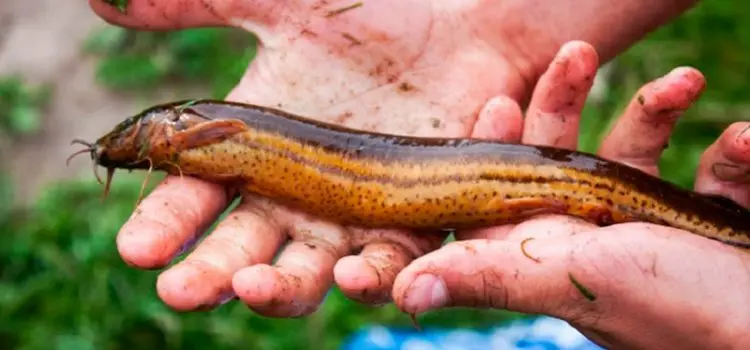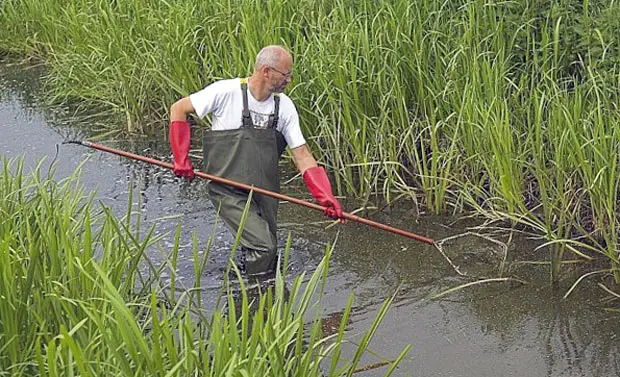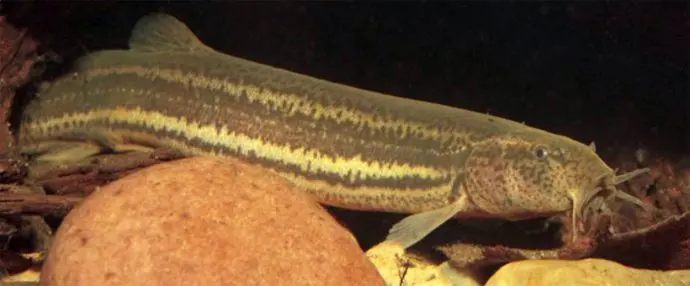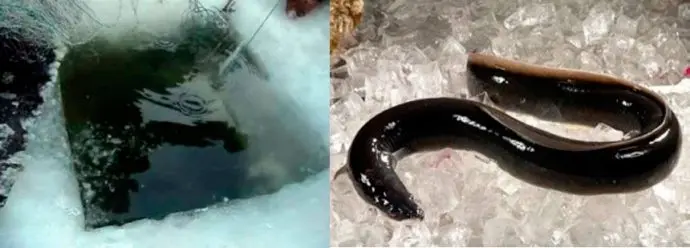Contents

Loach fishing has its own characteristics, so not every fisherman is ready to be interested in such fishing, despite the fact that the loach has the usual taste. This fish has unique survival abilities and is able to breed in small water areas.
Features of appearance
The loach belongs to the carp family and is a freshwater fish. It grows in length from 15 to 18 cm, but there are specimens up to 30 cm or more in size. It has an elongated body, covered with very small scales, but which can be seen with the naked eye. The caudal fin has a rounded shape, and 10-12 antennae can be seen around the mouth. There is an infraorbital, non-functioning, spike, located in the thickness of the skin. Males can be distinguished by an elongated and somewhat thickened second ray of the pectoral fin. To the left and right of the dorsal fin, there is a barely noticeable thickening formed by adipose tissue. If this fish has not been seen before, then it can be easily confused with an eel or a snake.

Therefore, the loach got its name, because of its appearance and ability to wriggle. It is possible that these factors had a direct impact on its popularity among fishermen. It is little used in food, and fishermen go for any fish, but not for loach.
All fins, like the rear fin, have rounded, very neat shapes. The loach has both pectoral and ventral fins, which are at some distance from the pectorals. The scales of the loach are almost invisible, because they are covered with a layer of mucus. On the back of an adult loach, black dots can be seen located on a yellow-brown surface. The loach’s belly can have different shades, depending on the living conditions: it can have both reddish and yellow colors. On the fins of a brown shade, you can also see small, black spots. The loach has small, yellow eyes.
Symmetrically, along the sides there are 3 black stripes, the middle of which is somewhat longer than the other 2. Depending on the habitat conditions, the full color of the loach may change: if you take a loach from a river with clean running water, then the loach will have lighter tones, and if you catch this fish in a pond with a muddy bottom and not so clear water, then the loach will have shade is much darker.
As mentioned above, individual specimens can reach a length of about 30 cm, while the thickness of such a fish can be equal to the thickness of the thumb of an adult.
Habitat
Most loach can be observed in the reservoirs of Central and East Asia. As for the European part, it is not so rich in this interesting fish. A certain number of loach was seen in the east of France, as well as in the reservoirs of Yekaterinburg and in the east of the Urals.

The fact that he moved to these areas indicates that the ecosystem began to be disturbed, as a result of which part of the swamps dried up, where he is the largest representative of the ichthyofauna. Quite a lot of this fish is found in the muddy reservoirs of the Western Urals, which give rise to the largest rivers in the Asian part of Russia. Most likely, this is the reason for its distribution closer to Asian regions.
In the Leningrad region, you can hardly meet loach, and only the Kronstadt Bay and Peipus can boast of the presence of this fish.
The loach prefers swampy terrain and all kinds of ditches with a large amount of silt. There is quite a lot of it in the swamps of Polesye, where it is common to catch it. It can be found in large quantities in the Kuban, but in the Crimea and the Caucasus it can hardly be found.
Features of food
The loach can eat quite a variety of food: larvae, molluscs, bloodworms, worms. It may well feed on the eggs of other fish species, which can reduce their numbers. It enjoys eating mosquito larvae.
As observations show, this representative of the underwater world is quite voracious and can damage the quantitative composition of other inhabitants, such as crucian carp or carp. But this can happen if there is a lack of other food in the reservoir. If the pond is muddy, then the loach will find food for itself, not paying attention to the caviar of other fish species.

breeding season
Not many people know when the loach starts and when it finishes spawning. This causes quite a bit of controversy. If you believe the observations of experienced fishermen, then the loach spawns in the spring, at the beginning of March. The only problem is that the spawning period can be extended in time. Some individuals begin spawning in winter. Females are quite prolific and can spawn from 15 to 150 thousand eggs. Nature has made sure that this unique species of fish has fed humans for thousands of years.
How to catch loach
Loach can be caught both in summer and in winter. In the summer, it can be caught with a regular float rod. The best option can be considered a fishing rod with a sensitive float, equipped with #3-#4 hooks. It is advisable to use a fishing line in green so that it does not stand out at the bottom, among silt and underwater thickets. The thickness of the fishing line can lie within 0,25 mm, although you can immediately tell that it is thick enough to catch loach, so you can use thinner fishing line. Especially large specimens will not have to be caught. Grasshoppers, bloodworms, bark beetle larvae or caddis flies can be used as bait.

According to the recommendations of experts, the bait should be thrown to the border of clean water and algae, and then slowly carried out. If there is a boat, then it can make the task easier. With the help of a boat, you can freely move with the flow. If there was a bite during the posting, but it was not possible to catch the fish, then you can return to the original one and repeat your actions. There should not be any particular problems with catching a loach if you have at least some skills in handling a fishing rod. At the same time, you need to have skills in handling the boat, and even more so, on the course.
The loach bites vigorously whether the fishing is day or night, although they are most active between sunset and nightfall. The loach bites specifically: the float can sink slightly and, as it were, go to the side. Cutting should be done after several such twitches. The loach’s appetite is quite large, so he swallows the bait instantly and completely, so there are practically no gatherings.
Instead of a hook, you can tie a needle to the main fishing line, this is how they practice catching eels. The needle is tied not behind the eye, but in the middle. The worm is put on a needle and the tackle is thrown. During the bite, when the loach swallows the worm with a needle, a cut is made and the needle becomes across, so that the fish will not have a chance to escape.
Winter fishing
Of great interest is winter fishing for loach. If in the summer, when the loach has enough food, it is problematic to wait for a bite, then in winter there is a way that allows you to catch hundreds of loaches throughout the winter. It should be said right away that it is somewhat unsuitable for a typical fisherman, because you need to go for fish very often and check the gear. As a rule, fishermen go fishing, especially in winter, for a day or two, but no more, but here, more time is needed.

In winter, the loach is caught on a specially made trap. Moreover, the guarantees of capture are very high if the loach is still found in the reservoir. In winter, the fish suffers from a lack of oxygen, and if the fish has such an opportunity, then it will definitely want to breathe fresh air. In this case, it is appropriate to recall winter fishing in general. An ignorant person can throw something like this: “They don’t have enough fish in the summer, so they also catch it in the winter”! It may be true, but the fact that the benefits of winter fishing are obvious is unambiguous. While on the pond, fishermen drill hundreds of holes through which the water is enriched with oxygen. Maybe they will catch something, but the fact that many more fish will be saved is for sure.
First you need to make a trap from a suitable dish. It can be a sieve without a bottom, a box without a bottom, a basket without a bottom, etc. A long time ago, such traps were woven from vines and successfully caught loaches. The bottom of the vessel is covered with a tarpaulin, in the center of which a hole is made into which the tube is inserted. It should be above the bottom, but below the trap itself, otherwise the loaches will be able to get out of the trap. It turns out a trap into which there is an entrance, but no exit. The tube should have a diameter slightly larger than the loach.
And now you can proceed to the most important thing – punching the hole. To prevent the hole from freezing, rods are laid on top, after which the hole is covered with hay or straw. After that, you will have to wait a few days until the loaches gather in the area of uXNUMXbuXNUMXbthe hole, wanting to breathe clean air. After that, the hole is expanded and a trap is placed in it, after which, the hole is covered again. The loaches rise to breathe and climb into the tube to the surface, but they can no longer get back. If you constantly monitor the hole, then you can have at least a dozen loaches every day. The benefits are mutual: the fish is good and the person is not hungry.
Vyun is a very tasty fish that can be fried, boiled and cooked in other dishes. Anyone who has ever tasted this fish will never forget this taste. Many consider loach meat a delicacy, although it is not so easy to catch it: it takes a lot of time, and the reservoir must be somewhere nearby, in which loaches must certainly be found.
We offer you a video about the underwater life of this very interesting fish.
If you wish, you can study in detail the principles of catching loach in winter by also watching the corresponding video.
In conclusion, it should be said that interest in this fish is lost in vain. Some 100 years ago, this fish saved entire families from starvation. Due to their fertility and ability to survive in extreme conditions, there were a lot of loaches in rates, ponds, small rivers and streams. His craftsmen caught throughout the winter and his stocks did not run out. Moreover, carp, tench and other fish coexisted next to the loaches. If there was enough food for the loach, then he did not pay attention to the eggs of other fish species, spending most of his life in mud and silt. He rose to the surface only in winter to take a breath of fresh air. Things are somewhat worse with the loach in our time, because some of the small streams have dried up, as well as parts of the small ponds, where the loach felt very good. He could be caught in any ditch, as long as there was water in it. Why did the loach prefer such reservoirs? Yes, most likely because in such rivulets and ponds there was not so much a predator as in large reservoirs with clear water and a solid bottom. Loach for predatory fish is a tasty morsel, so he is unlikely to be able to survive in such conditions, despite his fertility.









